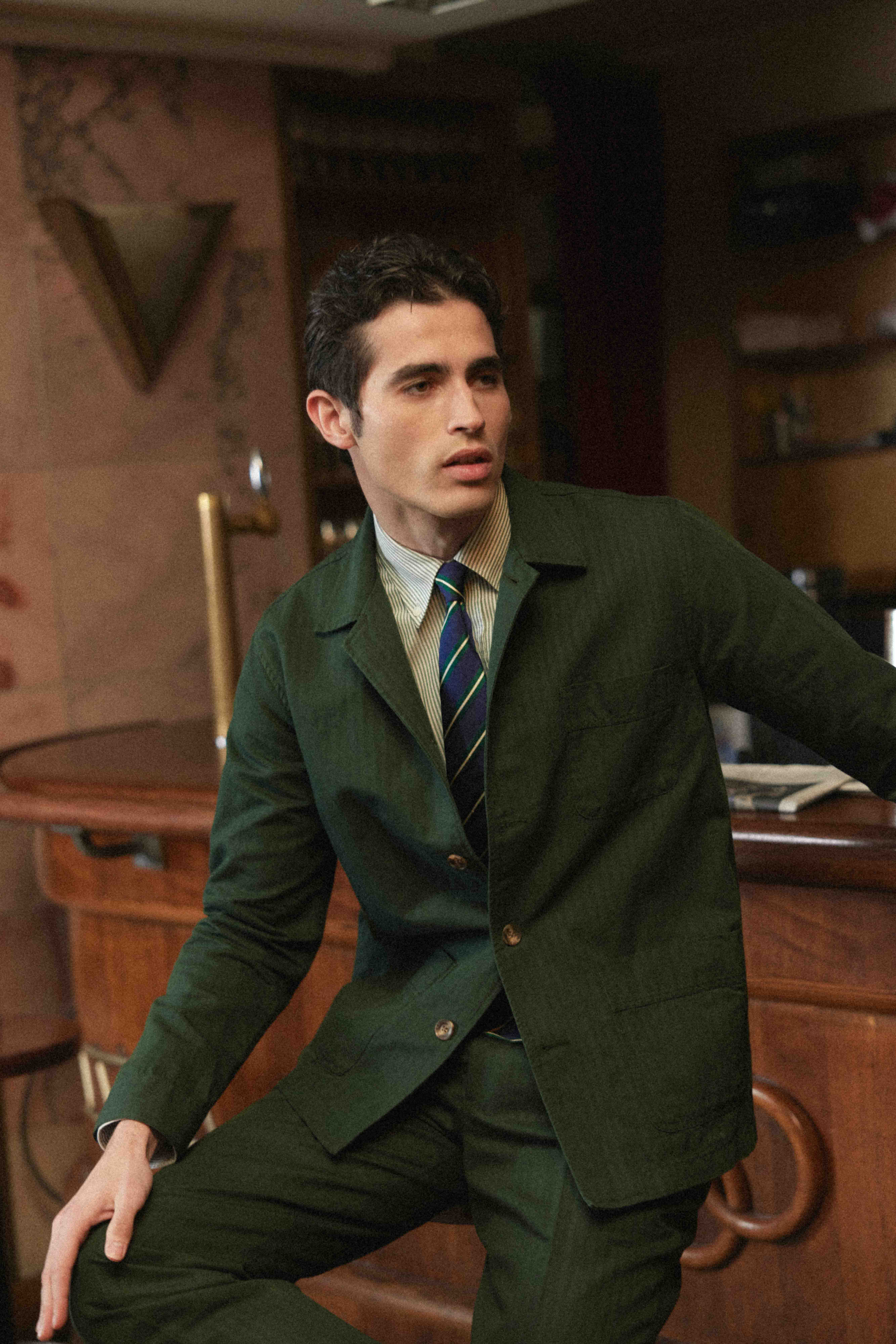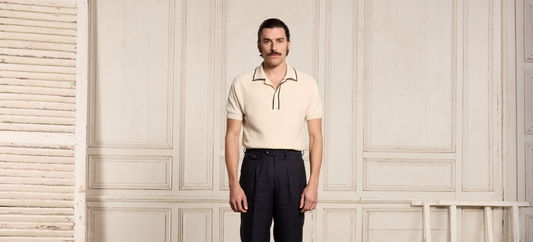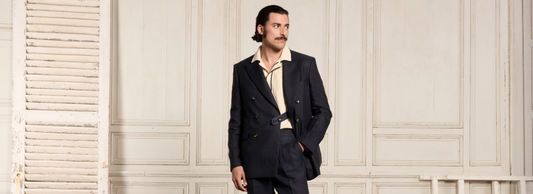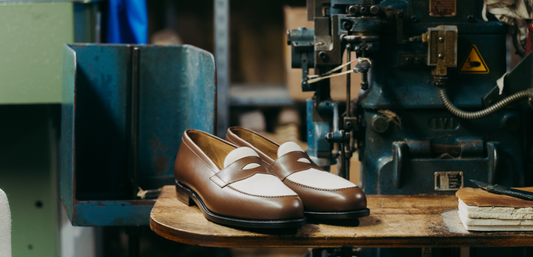Although it is difficult to precisely determine the date of birth of the work jacket, we can safely say that its destiny is closely linked to that of the industrial revolution . From the end of the 18th century and throughout the 19th, this garment experienced growing popularity by meeting the new needs of artisans and manual workers. In a context of mechanization where the role of machines is becoming more significant, clothing is adapting to the new situation to meet the needs of workers. Safety, robustness and practicality then become the key words for making reliable clothing, and it is in France that the work jacket becomes the queen . Recognizable by its signet ring collar, its imposing patch pockets and its moleskin fabric, it is gradually establishing itself as an absolute reference. In factories and workshops, the jacket thus supplants the blouse on men's backs thanks to properties which still characterize it today: it keeps warm , it is extraordinarily robust , it has a large storage capacity and it boasts a almost infinite life expectancy . Two centuries of changes later, this monument to French clothing heritage has not aged a bit and remains a centerpiece of the French wardrobe. An iconic item that Hast took over in 2019 with an ambition that has remained unchanged since: to conform this sacred monster to the uses of contemporary urbanites. Always with high standards, honesty and transparency , of course.
Safely
At the time, the work jacket was worn as a protective uniform, complemented by trousers made from the same material - often called "largeot" . This is no longer the case today and our beloved play, while retaining its early soul, has largely emancipated itself from working class circles. By capitalizing on our expertise in shirtmaking, we have declined it over time in a large number of materials , sizes and colors to make it a relevant ally for any occasion and in all registers.
This unique versatility, the work jacket draws from a timeless design that we have been able to put at the service of new lifestyles for today's men.
Finally, our interpretation of this Franco-French garment assumes the dual ambition of honoring its history and perpetuating it by adapting it to contemporary uses. In a workwear style , it will exude authenticity associated with chinos and a pair of boots; but nothing stops you from considering it in a formal outfit as a suit jacket. Its straight cut, clean lines and glorious design allow it to effortlessly transition from one style to another and integrate with both formal and casual outfits with equal ease. Open or buttoned all the way up, worn over a t-shirt or shirt, in a layering studied or not, with jeans or pleated pants, there is no look that can intimidate the one who is making the heyday of the tricolor wardrobe for over 200 years.
A historic cup
If the work jacket is among these few pieces recognizable at first glance, it is largely thanks to its legendary cut . As is often the case when the utility aspect was at stake, at the time it was a question of achieving a synthesis between security, protection, balance and efficiency: an equation successfully solved. The straight cut, the patch pockets, the mid-buttocks length, the buttoning, the signet collar: everything exudes both simplicity and necessity in this jacket that has become cult. By tackling its modernization in 2019 , there was obviously no question of betraying its origins, and it is in a spirit of homage that we designed all our work jackets . Unsurprisingly, you will find on each of them the invariants of this centuries-old history, combined with unique natural materials that stand the test of the third millennium.
Materials up to par
In the 19th and 20th centuries, cotton moleskin was featured on work jackets, renowned for its extraordinary strength and resistance to any test. At Hast, we have decided to introduce new materials, from the thickest to the lightest , and to work with different fabrics for today's men. You will therefore find:
Virgin wool . A natural, warm, insulating and temperature-regulating material, we obviously thought of it to dress some of our jackets. A bold and relevant variation that instantly injects a dose of elegance into the product without distorting it. Ours comes straight from Italy and weighs 320 g/m2 , making it an ideal partner for the off-season (and winter under a coat).
Recycled wool . You know our commitment to responsible production, and this does not stop at the selection of natural materials. For several years, we have strived to work with recycled materials at the same time, like this jacket made from an original fabric certified “Global Recycled Standard” : 70% recycled wool , 15% recycled polyester , 10% recycled polyamide and 5% other recycled fibers .
Velvet. If comfort was not the first concern of workers during the Industrial Revolution, we chose to give it a special place in our collections by introducing corduroy models with different rib sizes. Real cocoons of softness that will bring texture to your outfits and warmth to your hearts.
Flax. Before cotton supplanted them, it was hemp and linen that held the upper hand in the textile industry. The second, of which France is quite simply the world's leading producer , has today regained all its splendor and is returning to its former popularity. Considering its properties, this is not very surprising: it is a solid, breathable, absorbent, thermo-regulating natural fiber , requiring little water, completely recyclable and 100% biodegradable . More responsible, we don't know. As a bonus, it has a fairly rustic raw look that works wonderfully on work jackets. Unsurprisingly, we have worked on two in this gifted material: a 100% linen model for lovers of this material, and a cotton (23%) and linen (77%) variation to add a little extra softness .
Organic cotton twill. Recognizable by its oblique ribs obtained by a particular weaving, the twill is both flexible and very robust. It makes it possible to manufacture very resistant mid-weight fabrics (notably to tears), as illustrated by jeans which are the best representatives. Unsurprisingly, we have made some of our work jackets in organic cotton twill with a density of 290 g/m2 , the ideal weight for mid-season and cool summer evenings.
Denim. We no longer present this iconic material (which is, by the way, a form of twill), but it is worth pointing out that we gave ourselves the pleasure of cutting one of our jackets in this legendary fabric . An alternative to the denim jacket, this version, as refined as it is elegant, evokes the wild west and the traditional tricolor wardrobe at the same time, which only bodes well.
The indescribable moleskine , obviously. This material is new for 2022. We have got our hands on an Italian canvas created by a renowned Italian house to offer you a jacket of the height of authenticity. You will find the velvety texture of the original fabric and this “peach skin” appearance characteristic of moleskin. Obtained by weaving cotton threads very tightly in warp and weft, it displays a density and robustness which made it the ideal material for period workwear jackets . Resurrected for you, we offer you a 395 g/m2 edition which you will tell us about.
A cult collar and a wink
If you have followed closely, you know that the work jacket is historically linked to a particular collar: the signet ring collar . Unlike the lapel collar, open on the torso at the initiative of our British neighbors, this one goes up to the neck, so to speak. Eminently French, it has the advantage of covering the chest , throat and neck (thanks to flaps that can be raised). Respect for the product requires, this is the model that we have favored on our work jackets . On all our jackets? Not exactly, because we took the liberty of introducing a lovely rounded club collar on the denim model. A way of almost imperceptibly bringing an original and welcome twist to this anthology piece.
Unique colors
Gone are the days when the color of the work jacket indicated the trade of its wearer (black for carpenters, white for painters, Prussian blue for most other manual workers). At Hast, we have chosen to introduce a rich panel whose sole ambition is to bring the most beautiful shades possible to your outfits. Sober or bright, it's up to you to choose from the shades offered, all enhanced by luminous materials with exceptional texture. Duck blue or heather, anise green or olive, rust, plum, brown, navy, beige, khaki or even indigo : there is something for all tastes and for all occasions.
To wear in all circumstances
Like all the pieces that make up Hast's wardrobe, the work jacket shines with its versatility. Thanks to its sleek, timeless design , it is so versatile that it will easily adapt to any outfit you include it in. Whether you use it as a blazer paired with dress pants or take it back to its origins in a workwear look , whether you display it proudly or hide it between several layers of clothing in layering, it will always be ready to wear. serve ; and this from the first sweetness of spring to the first cold of winter. Despite proudly working-class roots, the whole challenge of its modernization was to allow a more general wear: this is done with the versions which are offered to you in unique materials and colors. Over jeans or chinos, covering a shirt (possibly tie) or a t-shirt, worn over a sweatshirt or a turtleneck, you will be delighted to see that all styles are allowed .
Taking care of your work jacket
Little open secret at the end: maintenance is half the life expectancy of your clothes. We may work them with the greatest possible care in excellent quality natural materials, mobilizing prestigious European know-how, but it is the care you take that will largely determine their durability. Concerning the work jacket, here are the few recommendations that we suggest you respect in this regard:
- When you are not wearing it, we strongly recommend storing it on a wide-shouldered wooden hanger . For it to maintain its beautiful shape over time and for it to naturally smooth out under the effect of gravity, it is simply essential.
- If there is a stain , a little soapy water should take care of most of them if you are responsive enough.
- Although the work jacket is an outer garment and it is not good to wash it every four mornings, a good cleaning will not hurt it two to three times a year . For this operation, we recommend washing by hand in barely lukewarm water, using organic detergent . For wool, recycled wool and moleskin models, you will need to go to the dry cleaners to have them dry cleaned .
- If you wash your twill or velvet jacket by hand, avoid twisting when spinning . Use pressure to remove most of the liquid, and let it dry on a hanger with the buttons closed.
With the work jacket, you touch on a part of French clothing heritage . Entry into the pantheon of iconic tricolor clothing thanks to a centuries-old history, this piece is known worldwide for its design and functionality. From 2019 , we capitalized on our expertise in shirting to make this utility jacket a model adapted to the new uses of our customers. Between tradition and modernity , we have declined this icon in different colors and materials to satisfy the desires and needs of today's men, without taking away anything from the elements which forged its legend. Timeless, versatile and full of personality, our interpretations of the work jacket are like the Hast wardrobe: a summary of elegance , versatility and authenticity .





















